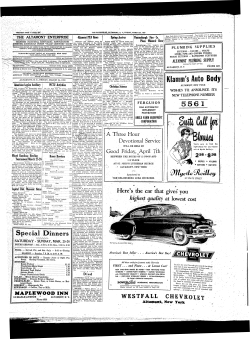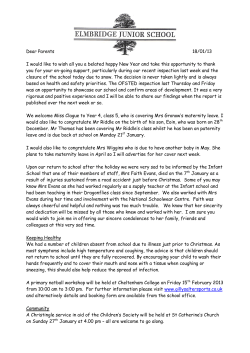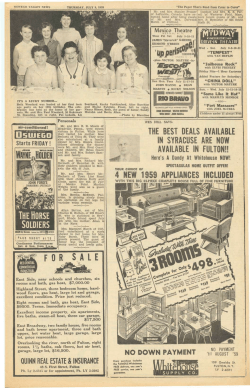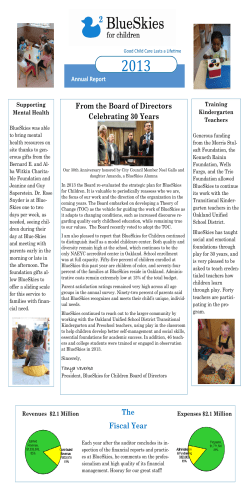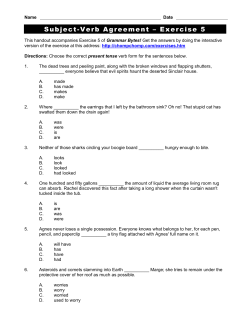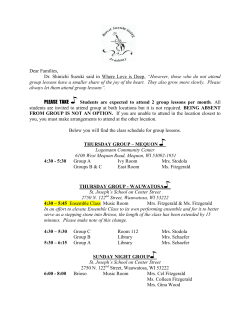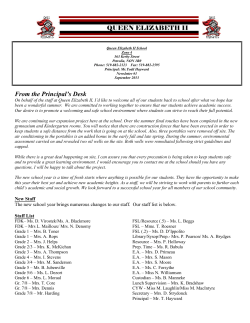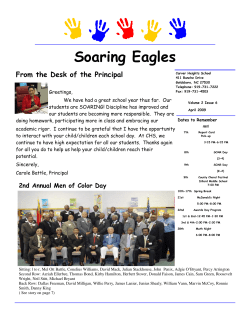
Traditional Literature Grades 3-5 By Mrs. Paula McMullen Library Teacher
Traditional Literature Grades 3-5 By Mrs. Paula McMullen Library Teacher Norwood Public Schools 4/28/2008 Mrs. McMullen, Library Teacher, Norwood Public Schools 1 What is Traditional Literature? ! ! ! ! ! Traditional literature includes the rhymes and stories that were originally told out loud in huts, tents, or around a fire, and passed down through the years Also called folklore, these stories have no known authors Told by people in all lands to explain their lives and their world Tell us how people thought and what they valued as a society through their themes Includes: rhymes, folktales, fables, legends, and myths 4/28/2008 Mrs. McMullen, Library Teacher, Norwood Public Schools 2 Types of Traditional Literature Traditional Literature Rhymes 4/28/2008 Folktales Fables Legends Mrs. McMullen, Library Teacher, Norwood Public Schools Myths 3 Folk Rhymes ! ! ! ! Folk rhymes are a type of traditional literature Mother Goose collections are best-known Includes: counting rhymes, finger play, play riddles, riddles games, games alphabets, time verses, songs, tongue twisters, nonsense rhymes superstitions, rhymes, superstitions and memorable characters Mention of these rhymes still f found d in i modern d literature lit t 4/28/2008 Mrs. McMullen, Library Teacher, Norwood Public Schools 4 Other Folk Rhyme Books 4/28/2008 Mrs. McMullen, Library Teacher, Norwood Public Schools 5 Folktales ! ! ! ! Folktales o a are a the most o common o o and a d familiar type of traditional literature Simple stories with talking beasts, kings and d princesses, i witches i h and d wishes i h Used for entertainment and education Sh Show values, l beliefs b li f and d traditions t diti off different groups of people 4/28/2008 Mrs. McMullen, Library Teacher, Norwood Public Schools Folktale Characteristics ! ! ! ! ! ! ! Set in distant past Characters all good or all bad Often f start with h “Once “ upon a time…”” Share lesson or belief Explore common themes: kindness, bravery and cunning are rewarded; evil, cruelty or laziness are punished Usually have happy endings Have special repeated details called ”motifs” (See slides 8-16) 4/28/2008 Mrs. McMullen, Library Teacher, Norwood Public Schools 7 Motifs ! ! ! A motif is a detail in a folktale that is repeated t d iin the th story Found in folktales around the world Give folktales their special flavor 4/28/2008 Mrs. McMullen, Library Teacher, Norwood Public Schools 8 Common Motifs Common motifs include: ! ! ! ! ! ! ! Special numbers 3 & 7 Magical creatures Magical objects Going on a quest Chants Enchantments Transformation 4/28/2008 Mrs. McMullen, Library Teacher, Norwood Public Schools 9 Special Number Motif ! ! ! ! ! Number 3 appears frequently in folktales Number of main characters: 3 little pigs, 3 Billy Goats Gruff, 3 bears Repeated actions or events: making 3 wishes, wishes crossing bridge 3 times, building 3 houses, Repetition builds interest or suspense in i story t Number 7 is less frequent special number: 7 Chinese brothers,, 7 dwarves 4/28/2008 Mrs. McMullen, Library Teacher, Norwood Public Schools 10 Magical Creatures Motif ! ! ! Magical creatures with special abilities in folktales include: fairies, elves, trolls, genies, giants, ogres, magical hens, witches and wizards Magical creatures can be bad or good Often serve as “magical helpers” to the main character: e.g., the fairy godmother helps Cinderella 4/28/2008 Mrs. McMullen, Library Teacher, Norwood Public Schools 11 Magical Objects Motif ! ! Magical objects in folktales include: pasta or porridge pot wand pot, wand, ring ring, beanstalk, beanstalk harp, doll, flying carpet and genie’s lamp, and talking eggs Used by the main character for help help, e e.g., g Jack climbs the magic beanstalk 4/28/2008 Mrs. McMullen, Library Teacher, Norwood Public Schools 12 Enchantment Motif ! ! ! Magical creatures often place other characters under enchantment, or spell Snow White and Sleeping Beauty were under spells Spells broken by acts of ki d kindness, bravery b or love l 4/28/2008 Mrs. McMullen, Library Teacher, Norwood Public Schools 13 Chants Motif ! ! Chants are short rhymes, or refrains, repeated t d iin story t Examples include: “Mirror Mirror Mirror on the Wall… Wall ” “Fee, Fo, Fum…” “Then I’ll huff and I’ll puff...” 4/28/2008 Mrs. McMullen, Library Teacher, Norwood Public Schools 14 Quest Motif ! ! Quest is special journey to obtain something of value: l stories from f the h Sky God, great riches, princess bride Quest involves completing p g 3 tasks despite danger 4/28/2008 Mrs. McMullen, Library Teacher, Norwood Public Schools 15 Transformation Motif ! ! ! Magical creatures transform themselves or another into different person, animal i l or object bj t Examples include: Prince changed into Beast Sno Beast; Snow White’s stepmother changing into old woman selling apples Transformation spell broken by act of love or kindness 4/28/2008 Mrs. McMullen, Library Teacher, Norwood Public Schools 16 Types of Folktales ! Special kinds of folktales include: fairy tales, trickster tales, and tall tales 4/28/2008 Mrs. McMullen, Library Teacher, Norwood Public Schools 17 Folktale Types Folktales Fairy Tales 4/28/2008 Trickster Tales Tall Tales Mrs. McMullen, Library Teacher, Norwood Public Schools 18 Fairy Tales ! ! ! ! ! Fairy tales are a type of folktale Magic g is keyy element Magical creatures are characters: fairies, giants, elves, witches and ogres Perform magical deeds of enchantment or transformation Have “happily ever after” ending 4/28/2008 Mrs. McMullen, Library Teacher, Norwood Public Schools 19 Other Fairy Tale Books 4/28/2008 Mrs. McMullen, Library Teacher, Norwood Public Schools 20 Trickster Tales ! ! ! ! ! Trickster tales are a type of folktale Smaller or weaker character uses cunning to outwit stronger, more powerful character h t Animal or human characters Tricksters c ste s ca can be se selfish s o or generous Show culture’s wisdom about human nature 4/28/2008 Mrs. McMullen, Library Teacher, Norwood Public Schools 21 Other Trickster Tale Books 4/28/2008 Mrs. McMullen, Library Teacher, Norwood Public Schools 22 Tall Tales ! ! ! ! Tall tales are a type of folktale Key element of exaggeration (hyperbole) includes character’s physical t it and traits d actions ti Exaggeration provides humor and exciting adventure Many American tall tales 4/28/2008 Mrs. McMullen, Library Teacher, Norwood Public Schools 23 Other Tall Tale Books 4/28/2008 Mrs. McMullen, Library Teacher, Norwood Public Schools 24 Fables ! ! ! ! ! ! Fables are a type of traditional literature Very brief stories Characters C a acte s are a e usually usua y animals a a s with t human characteristics – good or bad Teach obvious moral lesson for behavior Often end with a proverb, which is the stated moral of the fable; e.g., the fable “The Tortoise and the Hare” ends with the p proverb “Slow and steadyy wins the race.” Aesop’s fables are best-known examples 4/28/2008 Mrs. McMullen, Library Teacher, Norwood Public Schools 25 Other Fable Books 4/28/2008 Mrs. McMullen, Library Teacher, Norwood Public Schools 26 Legends ! ! ! ! Legends are a type of traditional literature Stories about famous heroes and their mighty deeds May be based on real person, but stories exaggerate hero’s actions (hyperbole) Heroes represent p ideas and values of a nation or people 4/28/2008 Mrs. McMullen, Library Teacher, Norwood Public Schools 27 Other Legend Books 4/28/2008 Mrs. McMullen, Library Teacher, Norwood Public Schools 28 Myths ! ! ! ! ! Myths are a type of traditional literature Explain natural phenomena: meanings of constellations, earthquakes, storms Explain origins of earth, fire or evil Often tell of gods and goddesses, heroes and monsters and their relationships with humans, and how humans came to be Best known myths are Greek, Roman, and Norse, but myths were told all over the world 4/28/2008 Mrs. McMullen, Library Teacher, Norwood Public Schools 29 Other Myth Books 4/28/2008 Mrs. McMullen, Library Teacher, Norwood Public Schools 30 Traditional Literature Flowchart Traditional Literature Rhymes Fairy Tales 4/28/2008 Folktales Fables Trickster Tales Tall Tales Mrs. McMullen, Library Teacher, Norwood Public Schools Legends Myths 31 Remember – ! ! ! ! ! ! Traditional literature includes the rhymes and stories of different groups of people all over the world that have been passed down orally through the years Have no known authors Used for education and entertainment Show values, beliefs and traditions of people Traditional literature includes: rhymes, folktales, fables, l legends d and d myths th Folktales are most common type of traditional literature They include: fairy tales, trickster tales, and tall tales 4/28/2008 Mrs. McMullen, Library Teacher, Norwood Public Schools 32 Acknowledgements ! ! ! ! ! ! ! Huck, Charlotte. Children’s Literature in the Elementary School. Fort Worth, Texas: Harcourt Brace Jovanovich College Publishers, 1987. Sutherland, Zena. Children and Books 8th ed. NY: HarperColllins Publishers, 1991. 1991 ClipartHeaven.Com http://clipartheaven.com/ Discoveryschool Clip Art Gallery http://school.discovery.com/clipart/ Follett Library Resources http://www.titlewave.com Kidsdomain Clip Art http://www.kidsdomain.com/clip/ Microsoft Office Clip Art http://office.microsoft.com/clipart/ 4/28/2008 Mrs. McMullen, Library Teacher, Norwood Public Schools 33
© Copyright 2026

